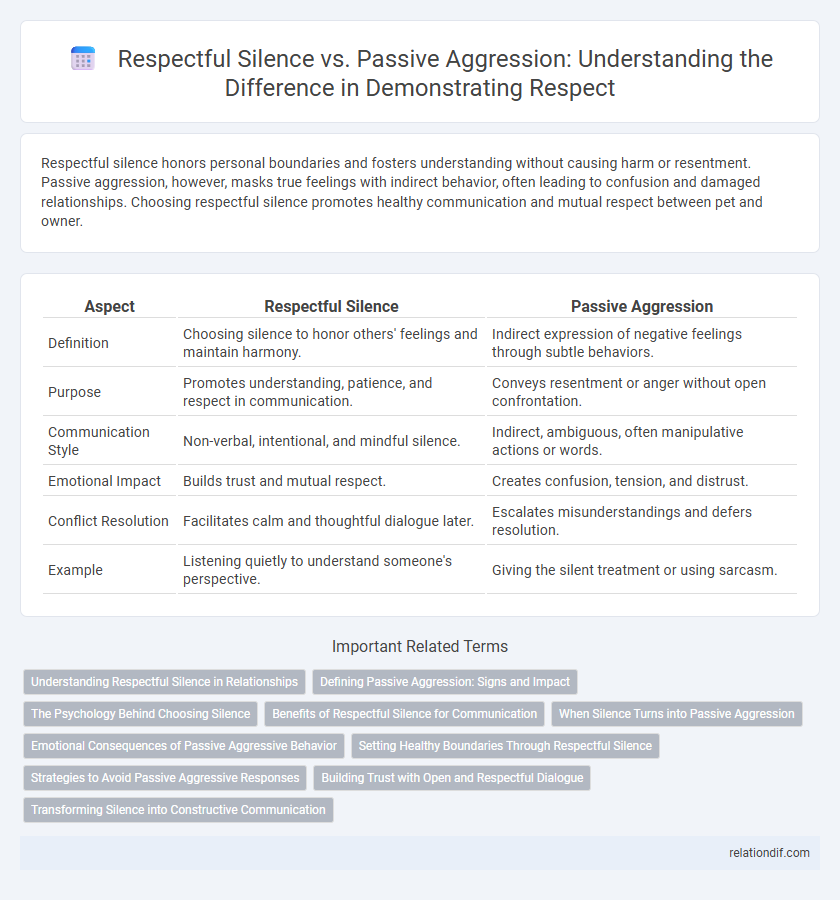Respectful silence honors personal boundaries and fosters understanding without causing harm or resentment. Passive aggression, however, masks true feelings with indirect behavior, often leading to confusion and damaged relationships. Choosing respectful silence promotes healthy communication and mutual respect between pet and owner.
Table of Comparison
| Aspect | Respectful Silence | Passive Aggression |
|---|---|---|
| Definition | Choosing silence to honor others' feelings and maintain harmony. | Indirect expression of negative feelings through subtle behaviors. |
| Purpose | Promotes understanding, patience, and respect in communication. | Conveys resentment or anger without open confrontation. |
| Communication Style | Non-verbal, intentional, and mindful silence. | Indirect, ambiguous, often manipulative actions or words. |
| Emotional Impact | Builds trust and mutual respect. | Creates confusion, tension, and distrust. |
| Conflict Resolution | Facilitates calm and thoughtful dialogue later. | Escalates misunderstandings and defers resolution. |
| Example | Listening quietly to understand someone's perspective. | Giving the silent treatment or using sarcasm. |
Understanding Respectful Silence in Relationships
Respectful silence in relationships functions as a powerful tool for thoughtful reflection and emotional regulation, allowing individuals to process feelings without immediate confrontation. Unlike passive aggression, which covertly communicates resentment or hostility through subtle, indirect means, respectful silence fosters trust and demonstrates consideration for the other person's perspective. Understanding this distinction is crucial for healthy communication, as it encourages openness while preventing the escalation of conflict.
Defining Passive Aggression: Signs and Impact
Passive aggression manifests through indirect resistance, such as sarcasm, procrastination, or subtle undermining, which often masks true feelings of anger or resentment. These behaviors disrupt effective communication and erode trust, making it difficult to address conflicts openly and respectfully. Recognizing signs like backhanded compliments, deliberate inefficiency, and silent treatment is crucial to fostering genuine respect and emotional transparency.
The Psychology Behind Choosing Silence
Respectful silence embodies conscious restraint and emotional regulation, promoting constructive reflection and empathy in social interactions. In contrast, passive aggression uses silence as a covert form of hostility, undermining trust and causing psychological distress. The psychology behind choosing silence hinges on emotional intelligence, self-control, and intention to either foster respect or mask unresolved conflict.
Benefits of Respectful Silence for Communication
Respectful silence enhances communication by allowing space for thoughtful reflection, reducing misunderstandings, and preventing unnecessary conflict. It fosters an environment where active listening and empathy thrive, strengthening trust between participants. Unlike passive aggression, respectful silence promotes clarity and emotional intelligence in conversations.
When Silence Turns into Passive Aggression
Respectful silence fosters understanding by allowing space for reflection and emotional regulation, promoting healthy communication. When silence shifts into passive aggression, it often manifests as indirect resentment, avoidance, or subtle hostility, undermining trust and escalating conflict. Recognizing this distinction is crucial for maintaining respectful relationships and addressing underlying issues directly.
Emotional Consequences of Passive Aggressive Behavior
Passive aggressive behavior generates emotional turmoil, fostering resentment and mistrust in relationships. Unlike respectful silence, which allows space for thoughtful reflection and emotional regulation, passive aggression covertly expresses negative feelings, leading to confusion and frustration. This emotional toxicity undermines communication, causing long-term damage to bonds and reducing overall psychological well-being.
Setting Healthy Boundaries Through Respectful Silence
Respectful silence serves as a powerful tool for setting healthy boundaries by allowing space for reflection and emotional regulation without escalating conflict. Unlike passive aggression, which covertly expresses hostility through indirect behavior, respectful silence communicates self-respect and clear limits without verbal confrontation. This intentional pause fosters mutual understanding and preserves dignity, promoting healthier, more respectful relationships.
Strategies to Avoid Passive Aggressive Responses
Respectful silence involves consciously choosing not to respond in a way that escalates conflict, demonstrating emotional regulation and self-control. Strategies to avoid passive-aggressive responses include clear communication of feelings, setting boundaries assertively, and practicing empathy to understand the other person's perspective. Developing emotional intelligence and using mindfulness techniques help prevent misunderstandings and promote respectful dialogue.
Building Trust with Open and Respectful Dialogue
Respectful silence fosters trust by allowing space for thoughtful reflection and showing consideration for others' feelings, while passive aggression undermines trust through indirect hostility and unclear communication. Building trust requires open and respectful dialogue where honesty and empathy promote understanding and strengthen relationships. Prioritizing transparent communication over passive aggression creates a foundation for mutual respect and lasting trust.
Transforming Silence into Constructive Communication
Respectful silence fosters understanding by allowing space for reflection and emotional regulation, whereas passive aggression often masks frustration and leads to miscommunication. Transforming silence into constructive communication involves expressing thoughts calmly and clearly, promoting openness and trust. Effective dialogue replaces the ambiguous nature of silence with meaningful interactions that enhance mutual respect.
Respectful silence vs Passive aggression Infographic

 relationdif.com
relationdif.com